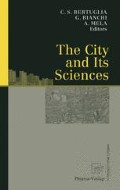Abstract
Modern science has been marked, from its birth to our days, by an analytical approach to the complexity of real world phenomena: complexity has been decomposed into simple objects and ‘basic laws’ deriving from observation at this fundamental level have been proposed1 (see e.g. Oldroyd, 1986, for an extensive and detailed discussion). One could say that this approach tries to understand the world in the same way that children do when they discover the internal structure of a toy by taking it apart. In recent years the scientific approach to the study of complexity has undergone a deep transformation that can be interpreted as an overall change of paradigm2 (see e.g. Ceruti, 1992).
Access this chapter
Tax calculation will be finalised at checkout
Purchases are for personal use only
Preview
Unable to display preview. Download preview PDF.
References
Arecchi F.T., Arecchi I. (1990) I simboli e la realtà. Temi e metodi della scienza, Jaca Book, Milan.
Arlinghaus S.L. (1985) Fractals Take a Central Place, Geografiska Annaler, 67B, 83–88.
Avarello P., Cuzzer A. (1982) Urbanistica e mercato edilizio, Sansoni, Florence.
Bak P., Chen K. (1991) La criticità auto-organizzata, Le Scienze, 271, 22–30.
Batty M., Longley P. (1994) Fractal Cities, Academic Press, London.
Briggs J. (1992) Fractals. The Patterns of Chaos, Simon and Schuster, New York.
Campos Venuti G. (1994) La terza generazione dell’urbanistica, Angeli, Milan.
Caniggia G., Maffei G.L. (1993) Lettura dell’edilizia di base, Marsilio, Venice.
Carrà S. (1989) La formazione delle strutture, Bollati Boringhieri, Turin.
Ceruti M. (1992) Il vincolo e la possibilità, Feltrinelli, Milan.
Cini M. (1994) Un paradiso perduto. Dall’universo delle leggi naturali al mondo dei processi evolutivi, Feltrinelli, Milan.
Cortesi A. (1979) Cultura urbana, progetto, disegno urbano, in Paoli P., Cortesi A. (eds.) Disegno urbano. Una proposta per la città come sistema, Pitagora, Bologna, 95–124.
Donato F., Lucchi Basili L. (1996) L’ordine nascosto dell’organizzazione urbana. Un’applicazione della geometria frattale e della teoria dei sistemi autoorganizzati alla dimensione spaziale degli insediamenti, Angeli, Milan.
Guidoni E. (1992) L’arte di progettare le città. Italia e mediterraneo dal medioevo al settecento, Kappa, Rome.
Haken H. (1981) Erfolgsgeheimnisse der Natur, Deutsche-Verlags, Anstalt.
Hillier B. (1988) La morfologia urbana e le leggi dell’oggetto, in Zanella P. (ed.) Morfologia dello spazio urbano. Questioni di analisi e di progetto, Angeli, Milan, 29–64.
Liverani M. (1988) L’origine della città. Le prime comunità urbane del vicino oriente, Editori Riuniti, Rome.
Lynch K. (1981) A Theory of Good City Form, MIT Press, Cambridge, Massachusetts.
Mandelbrot B. (1975) Les objets fractals, Flammarion, Paris.
Mumford L. (1961) The City in History, Harcourt, Brace and Jovanovic, New York.
Oldroyd D. (1986) The Arch of Knowledge. An Introductory Study of the History of the Philosophy and Methodology of Science, Methuen, New York.
Paba G. (1990) Limiti e confini della città: un’introduzione, in Paba G. (ed.) La città e il limite, La Casa Usher, Florence, 8 - 21.
Peitgen H.O., Richter P.H. (1986) The Beauty of Fractals. Images of Complex Dynamical Systems, Springer-Verlag, Berlin.
Prusinkiewicz P., Lindenmayer A. (1990) The Algorithmic Beauty of Plants, Springer- Verlag, Berlin.
Ruelle D. (1991) Determinismo e predicibilità, in Casati G. (ed.) Il caos. Le leggi del disordine, Le Scienze, Milan, 13–21.
Schroeder M. (1991) Fractals, Chaos, Power Laws. Minutes From an Infinite Paradise, Freeman, New York.
Schumacher T. (1978) Buildings and Streets: Notes On Configuration and Use, in Anderson S. (ed.) On Streets, MIT Press, Cambridge, Massachusetts.
Secchi B. (1984) Piccoli centri, Casabella, 504, 14–15.
Serra R., Zanarini G. (1986) Auto-organizzazione in universi artificiali, in Serra R., Zanarini G. (eds.) Tra ordine e caos. Auto-organizzazione e imprevedibilità nei sistemi complessi, Clueb, Bologna, 115–151.
Tinacci Mossello M. (1990) Geografìa economica, Il Mulino, Bologna.
Vallega A. (1995) La regione, sistema territoriale sostenibile. Compendio di geografia regionale sistematica, Mursia, Milan.
Vulpiani A. (1994) Determinismo e caos, Nuova Italia Scientifica, Rome.
Zanarini G. (1994) Finestre sulla complessità. Ordine e caos nella natura, Editoriale Scienza, Trieste.
Editor information
Editors and Affiliations
Rights and permissions
Copyright information
© 1998 Physica-Verlag Heidelberg
About this paper
Cite this paper
Basili, L.L. (1998). The Fractal Geometry of Urban Organisation: Beyond the Crisis of ‘Spontaneous Order’. In: Bertuglia, C.S., Bianchi, G., Mela, A. (eds) The City and Its Sciences. Physica-Verlag HD. https://doi.org/10.1007/978-3-642-95929-5_8
Download citation
DOI: https://doi.org/10.1007/978-3-642-95929-5_8
Publisher Name: Physica-Verlag HD
Print ISBN: 978-3-642-95931-8
Online ISBN: 978-3-642-95929-5
eBook Packages: Springer Book Archive

